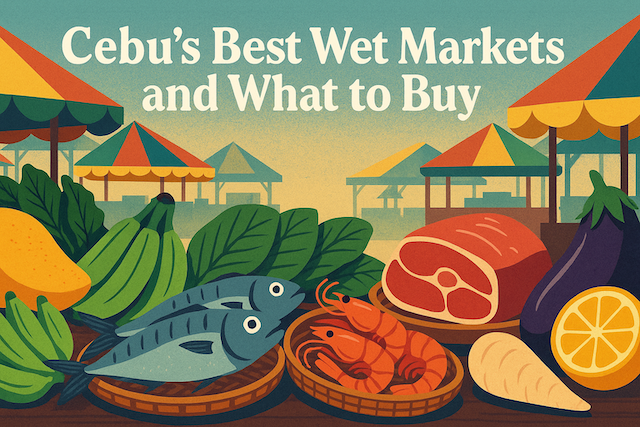Cebu’s Best Wet Markets and What to Buy

Contents
- Cebu’s Best Wet Markets and What to Buy
- Why Visit a Wet Market?
- 1. Carbon Market – The Granddaddy of Cebu Wet Markets
- 2. Pasil Fish Market – For the Ultimate Seafood Lover
- 3. Mandaue Public Market – Northern Metro Gem
- 4. Lapu-Lapu Public Market – Island Fresh
- 5. Talisay Public Market – For the Lechon Experience
- 6. Banawa Market – Small, Clean, and Central
- 7. Taboan Market – Dried Fish Capital
- Cultural Tips for Foreigners
- Is It Safe and Clean?
- Tips for Expats and Tourists
- Wet Market vs. Supermarket
- What You Can Expect to Spend
- Final Thoughts
- Frequently Asked Questions about Wet Markets in Cebu
- What is a wet market?
- Is it safe for foreigners to shop in Cebu’s wet markets?
- What time should I visit the wet markets?
- Do I need to speak Cebuano or Filipino to shop at a wet market?
- Can I bargain in wet markets?
- Are prices lower than supermarkets?
- Is there parking available near the markets?
- What should I bring with me?
- Are there vegetarian or vegan options?
- Is credit card payment accepted?
- How do I ensure the seafood I buy is fresh?
- Which markets are the most tourist-friendly?
- Are wet markets hygienic?
- Are there street foods around the markets?
- Can I bring children or elderly companions?
- Are there guided tours available?
- Which market is best for dried fish like danggit?
- How do I store fresh market purchases?
Cebu’s Best Wet Markets and What to Buy
When it comes to truly experiencing the heartbeat of a city, nothing compares to visiting its local markets. In Cebu, the wet markets—known locally as taboan or merkado—are a sensory explosion of colors, smells, and sounds. These bustling hubs are where locals shop for the freshest seafood, vegetables, tropical fruits, spices, and even household goods. Whether you’re a home cook, an adventurous foodie, or an expat looking for budget-friendly ingredients, Cebu’s wet markets offer a cultural experience and unbeatable value.
In this guide, we’ll explore the best wet markets in Cebu, what to buy in each, how to navigate them as a foreigner, and practical tips for bargaining, hygiene, and safety.
Why Visit a Wet Market?
Wet markets are not just about food—they’re about connection. Vendors remember your name, offer cooking tips, and greet you with a smile. The goods are fresh, the prices are fair, and you’ll likely discover fruits or seafood you’ve never seen before. Many of these markets open early and serve as social hubs for locals, so arriving before 9 AM gives you the best picks.
1. Carbon Market – The Granddaddy of Cebu Wet Markets
Located near downtown Cebu City, Carbon Market is the oldest and largest public market in the city. It has been operating for over a century and recently underwent modernization to improve cleanliness and organization.
What to Buy:
-
Fresh Seafood: Prawns, crabs, milkfish (bangus), squid, and reef fish caught that morning.
-
Local Vegetables: Malunggay, kangkong, eggplants, and native root crops like cassava and taro.
-
Fruits: Mangoes, bananas, jackfruit, and seasonal durian.
-
Dried Fish: A famous section of Carbon Market is Taboan, where vendors sell danggit (crispy dried fish) and pusit (dried squid).
-
Spices & Native Vinegars: Buy in small sachets or refillable bottles.
Insider Tip:
Bring a mask or handkerchief—parts of the market can be pungent, especially in the dried fish areas.
2. Pasil Fish Market – For the Ultimate Seafood Lover
Located just a few minutes from Carbon, Pasil is Cebu’s largest seafood trading hub. It starts operating as early as 2 AM when fishermen arrive with their catch.
What to Buy:
-
Live Crabs and Shellfish: Mud crabs (alimango), oysters, and clams.
-
Exotic Catch: Flying fish, swordfish steaks, and baby octopus.
-
Bulk Seafood: Ideal for group cooking or restaurant owners.
Caution:
This market is less tourist-friendly than others—go with a local or guide if it’s your first visit.
3. Mandaue Public Market – Northern Metro Gem
Serving the Mandaue area, this market is cleaner and less chaotic than Carbon, making it ideal for first-time visitors.
What to Buy:
-
Lechon Supplies: Herbs and lemongrass for stuffing a whole pig.
-
Local Sausages: Mandaue longganisa is sweet and garlicky.
-
Cebuano Street Snacks: Puso (hanging rice), fried bananas, and tempura.
4. Lapu-Lapu Public Market – Island Fresh
If you’re staying in Mactan Island, the Lapu-Lapu City Market is your best bet. Located near the old city hall, this market is a go-to for island residents.
What to Buy:
-
Fresh Catch: Tuna belly, lapu-lapu (grouper), and marlin.
-
Tropical Fruits: Dragonfruit, lanzones, rambutan in season.
-
Shells and Local Crafts: Handmade jewelry, shell-based home décor.
5. Talisay Public Market – For the Lechon Experience
Talisay City is known as the lechon capital of Cebu, and their public market is heavily geared toward ingredients that go with this Cebuano delicacy.
What to Buy:
-
Roast Pig Cuts: Buy freshly cooked lechon by the kilo.
-
Side Dishes: Pickled papaya (atchara), vinegar, and spicy sauce.
-
Sweet Delicacies: Coconut candies, cassava cake, and rice snacks.
6. Banawa Market – Small, Clean, and Central
A compact wet market located near residential subdivisions in Banawa. It’s perfect for quick grocery runs and light bargaining.
What to Buy:
-
Organic Veggies: Many vendors source from mountain barangays.
-
Fresh Tofu & Tempeh: Great for vegetarians.
-
Buko (Coconut) Water: Straight from the shell for ₱25–₱35.
7. Taboan Market – Dried Fish Capital
This section within Carbon Market is so iconic, it deserves a separate mention. The scent of danggit (sun-dried rabbitfish) fills the air and often clings to your clothes for hours.
What to Buy:
-
Danggit: Perfect with garlic rice and vinegar dip.
-
Pusit (Dried Squid): A local breakfast favorite.
-
Buwad na Pirit (Anchovy-like dried fish): Cheap and great for soups.
Visit Taboan Market for Dried Fish: Cebu’s Authentic Pasalubong Experience [2025 Guide]
Cultural Tips for Foreigners
-
Bargain Politely: Vendors expect some haggling, especially if you’re buying in bulk.
-
Bring Small Bills: Most stalls can’t break ₱1000 notes.
-
Use Local Terms: Say “gamay” for small, “dako” for big. It helps build rapport.
-
Don’t Point with Fingers: Use your whole hand or lips—it’s more polite in Filipino culture.
Is It Safe and Clean?
Wet markets can appear chaotic, but most are generally safe during the day. Watch your belongings, wear closed shoes, and avoid stepping on wet surfaces.
For hygiene:
-
Wash all produce thoroughly.
-
Avoid seafood that smells “off” or has cloudy eyes.
-
Many markets now provide plastic gloves for buyers—use them!
Tips for Expats and Tourists
-
Go Early: Between 5:00 AM and 9:00 AM is the sweet spot for freshness.
-
Bring a Basket or Eco Bag: Plastic bags are being phased out in Cebu.
-
Visit with a Local: Some vendors may raise prices for foreigners, but locals will help you get the real rate.
-
Try the Street Food Nearby: Wet markets are surrounded by eateries serving everything from rice porridge (lugaw) to grilled intestines (isaw).
Wet Market vs. Supermarket
| Feature | Wet Market | Supermarket |
|---|---|---|
| Price | Lower | Higher |
| Freshness | Same-day catch | Often refrigerated |
| Variety | Local & seasonal | Imported |
| Hygiene | Variable | Controlled |
| Cultural Value | High | Low |
What You Can Expect to Spend
Here’s a rough guide for common items:
-
1 kilo of mangoes: ₱80–₱120
-
1 kilo of milkfish: ₱150–₱180
-
1 bundle of kangkong: ₱10
-
100g of danggit: ₱80
-
1 liter of coconut vinegar: ₱40
Final Thoughts
Cebu’s wet markets are not just grocery stops—they’re living, breathing parts of the city’s culture. From bargaining with seasoned vendors to trying exotic seafood or munching on fresh banana cue, every visit is a mini-adventure. Whether you’re here long-term or just passing through, make time to explore a market. It’s where real Cebuano life unfolds.
Frequently Asked Questions about Wet Markets in Cebu
What is a wet market?
A wet market refers to a traditional, open-air market where fresh meat, seafood, vegetables, fruits, and other perishable goods are sold. The term “wet” comes from the practice of regularly cleaning the floors with water, especially in seafood and meat sections.
Is it safe for foreigners to shop in Cebu’s wet markets?
Yes, wet markets in Cebu are generally safe during daylight hours. Most markets are crowded but friendly. However, basic precautions like securing your belongings, wearing closed-toe shoes, and avoiding isolated sections are advised.
What time should I visit the wet markets?
The best time to visit wet markets is between 5:00 AM and 9:00 AM. This is when the freshest produce and seafood are available. Some seafood markets like Pasil start even earlier, around 2:00–3:00 AM.
Do I need to speak Cebuano or Filipino to shop at a wet market?
No, but learning a few basic terms can help build rapport and get better prices. Most vendors understand basic English. Common phrases like “Pila ni?” (How much is this?) and “Barato ra?” (Can it be cheaper?) are appreciated.
Can I bargain in wet markets?
Yes, bargaining is a common practice in Cebuano markets. Be respectful and polite. If you’re buying in bulk or are a repeat customer, you’re more likely to get a discount.
Are prices lower than supermarkets?
Generally, yes. Wet markets offer better prices, especially for locally grown produce and seafood. Imported goods are rare, but native products are more affordable compared to grocery chains.
Is there parking available near the markets?
Larger markets like Carbon and Lapu-Lapu Public Market usually have designated parking areas, but they can get crowded early in the morning. It’s often better to use public transport or ride-hailing apps.
What should I bring with me?
- Reusable bags or baskets
- Small bills and coins
- Alcohol spray or wipes
- Water bottle and sunscreen (for outdoor markets)
Are there vegetarian or vegan options?
Absolutely. You can find a wide variety of leafy greens, fruits, tubers, tofu, and fresh herbs. Some markets also sell tempeh, fermented rice cakes, and other meat alternatives. Organic vendors are more common in Banawa and Mandaue markets.
Is credit card payment accepted?
Most vendors only accept cash. It’s rare to find mobile wallets or QR code payments in traditional markets. Bring smaller denominations (₱20, ₱50, ₱100) for easier transactions.
How do I ensure the seafood I buy is fresh?
Look for clear eyes, red gills, firm flesh, and a clean smell. If the fish smells sour or ammonia-like, it’s best to skip it. For shellfish, tap the shells to check if they close—they should react if alive.
Which markets are the most tourist-friendly?
Banawa and Mandaue Public Markets are cleaner and easier to navigate for first-time visitors. Carbon Market has the most variety but is more chaotic. Lapu-Lapu Market is also friendly and near resorts on Mactan Island.
Are wet markets hygienic?
Hygiene standards vary. Some modernized markets like Carbon have improved layouts and sanitation. Still, it’s important to wash all produce and sanitize your hands after visiting. Avoid touching raw meat or seafood directly unless using provided gloves or utensils.
Are there street foods around the markets?
Yes! Wet markets are usually surrounded by small eateries and food stalls selling Filipino favorites like banana cue, turon, pork barbecue, puso (hanging rice), and lugaw (rice porridge). Many locals grab breakfast after their morning market run.
Can I bring children or elderly companions?
Yes, but exercise caution. Wet markets are busy, and some areas can be slippery or crowded. Consider going early when it’s less packed and bringing water and face towels to stay comfortable.
Are there guided tours available?
Yes, some local travel agencies and food tour companies offer guided market tours that include breakfast or cooking demos. This is a great option if you’re new to Cebu or want a deeper cultural experience.
Which market is best for dried fish like danggit?
Taboan Market, a section of Carbon, is famous for dried fish including danggit, pusit, and anchovies. If you’re buying to bring back home, vendors will vacuum-seal your order for transport.
How do I store fresh market purchases?
For meat and seafood, refrigerate or freeze immediately. Leafy greens should be wrapped in paper towels and stored in breathable bags. Fruits can be kept in a dry basket out of direct sunlight unless overly ripe.




